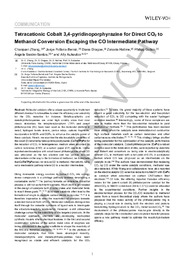Título :
Tetracationic Cobalt 3,4-pyridinoporphyrazine for Direct CO2 to Methanol Conversion Escaping the CO Intermediate Pathway |
Autor :
Zhang, Chanjuan
Follana-Berná, Jorge
Dragoe, Diana
Halime, Zakaria
Gotico, Philipp
Sastre-Santos, Ángela 
Aukauloo, Ally |
Editor :
Wiley |
Departamento:
Departamentos de la UMH::Farmacología, Pediatría y Química Orgánica |
Fecha de publicación:
2024-08-01 |
URI :
https://hdl.handle.net/11000/33848 |
Resumen :
Molecular catalysts offer a unique opportunity to implement different chemical functionalities to steer the efficiency and selectivity for the CO2 reduction for instance. Metalloporphyrins and metallophthalocyanines are under high scrutiny since their most classic derivatives the tetraphenylporphyrin (TPP) and parent phthalocyanine (Pc), have been used as the molecular platform to install, hydrogen bonds donors, proton relays, cationic fragments, incorporation in MOFs and COFs, to enhance the catalytic power of these catalysts. Herein, we examine the electrocatalytic properties of the tetramethyl cobalt (II) tetrapyridinoporphyrazine (CoTmTPyPz) for the reduction of CO2 in heterogeneous medium when adsorbed on carbon nanotubes (CNT) at a carbon paper (CP) electrode. Unlike reported electrocatalysis with cobalt based phthalocyanine where CO was advocated as the two electron and two protons reduced intermediate on the way to the formation of methanol, we found here that CoTmTPyPz does not reduce CO to methanol. Henceforth, ruling out a mechanistic pathway where CO is a reaction intermediate.
|
Área de conocimiento :
CDU: Ciencias puras y naturales: Química |
Tipo de documento :
info:eu-repo/semantics/article |
Derechos de acceso:
info:eu-repo/semantics/openAccess |
DOI :
https://doi.org/10.1002/ange.202411967 |
Publicado en:
Angewandte Chemie, 2024 |
Aparece en las colecciones:
Artículos - Farmacología, Pediatría y Química Orgánica
|
 La licencia se describe como: Atribución-NonComercial-NoDerivada 4.0 Internacional.
La licencia se describe como: Atribución-NonComercial-NoDerivada 4.0 Internacional.
.png)
